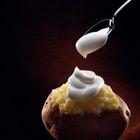
While it’s true that you don’t need a special butter churn to turn heavy cream into a bit of homemade butter, using ultra pasteurized cream from your grocery store will not produce the same results. Ultra pasteurization destroys harmful bacteria that were once responsible for life-threatening illnesses, but it also destroys the good bacteria needed to culture butter.
Pasteurized vs. Ultra Pasteurized
Most cream sold in grocery stores today is pasteurized, meaning every particle of the product has been heated to 161 degrees Fahrenheit for at least 15 seconds, followed by rapid cooling. Cream labeled as “ultra pasteurized” has been heated under pressure to much higher temperatures -- 280 to 320 degrees F. This process allows dairy distributors to collect cream from multiple dairy farms while ensuring safety and does not alter the nutritional content of dairy products. However, the higher temperatures kill more microorganisms, which is why ultra pasteurized cream cannot be made into butter without culture additives.
The Missing Culture
Cream made from milk that has not been pasteurized or homogenized is known as “raw cream.” It is biologically active, meaning it contains bacteria such as lactobacillus that ferments the cream, giving butter its satisfying flavor. When cream is ultra pasteurized, all bacteria -- good and bad -- is destroyed. Making butter from ultra pasteurized cream requires the addition of these missing cultures, which can be purchased from cheesemaking supply companies.
Whipping Cream Differences
Pasteurized cream marked as “heavy cream” or “whipping cream” must contain between 36 to 40 percent butterfat. It is the carotene from the fat that gives butter its rich yellow color. While over-whipping pasteurized cream can result in butter, ultra-pasteurized cream does not whip as easily. Some brands of ultra pasteurized cream add stabilizers to aid in whipping, but these additives are not the same as cultures and do not help the cream to become butter when vigorously whipped.
Using and Storing
While pasteurized cream can be stored unopened for up to 18 days, ultra pasteurized cream has a shelf-life over three times that at 60 days. The product should still be refrigerated between 33 and 39 degrees F, and once opened, used within seven days. Larger containers of ultra pasteurized cream can last as long as 15 days once opened. When cooking with cream, do not pour any unused amounts that have been brought to room temperature back into the storage carton, or bacteria growth may occur. Instead, refrigerate the cream in a separate container if it has not been left at room temperature for more than two hours.
Related Articles

Why Does Cream Turn Into Butter?

What Is "Cultured Cream"?

Is Whipping Cream Supposed to Be Chunky?
Cream vs. Creamer

Different Types of Whipping Cream
Does Sour Cream Go Bad if Unopened?

Can You Make Instant Pudding With Heavy ...

How Many Calories Are in Cream of Wheat?
Clotted Cream Vs. Double Cream

What Happens if I Forget to Refrigerate ...
The Difference Between ...

Why Does Some Alcohol Curdle Cream?

How to Substitute Cream for Buttermilk

Does Cream Curdle When It Goes Bad?

Estrogen in Skin Creams

Differences Between Double Cream and ...

Permanent Hair Removal Creams & Lotions

How to Make Whipped Frosting Without ...

How to Bring Cream to a Boil

Substitute for Heavy Whipping Cream in ...
References
Resources
Writer Bio
For more than 10 years, Carol Butler has run a small, off-grid furniture business with her husband and is a regular contributor to the Edible community of magazines. As staff writer for RichLife Advisors, she covers financial planning and other industry-related topics. She holds a B.F.A. in theater arts.
Photo Credits
Jupiterimages/BananaStock/Getty Images